In this article:
Plaque refers to a transparent or pale yellow biofilm that forms on the teeth, gums, tongue, and other surfaces inside your mouth. It is composed of saliva, food debris, and fluids that provide sustenance to oral bacteria.

If you don’t clean the mouth properly daily, these bacteria will continue to grow at a rapid rate and form even more plaque. The sticky plaque can harden over time after mixing with the calcium from your saliva and form yellow or brown deposits called tartar or calculus on the teeth.
Unlike plaque, which can be removed through proper oral hygiene, tartar is much more difficult to get rid of and usually requires a professional dental cleanup.
Home Remedies for Plaque and Tartar
The following remedies might help in slowing down the growth of plaque bacteria and keep your teeth healthy for longer.
Note: Alternative antiplaque agents such as baking soda and aloe vera can be more abrasive than over-the-counter toothpaste containing these ingredients and should be used with caution.
1. Try oil pulling
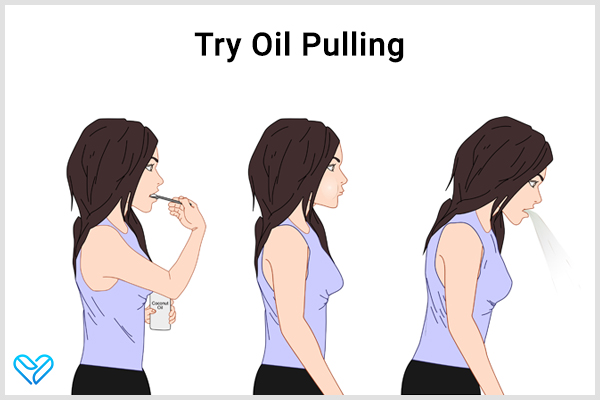
The practice of oil pulling for oral hygiene goes back a long time and has yielded positive outcomes in reducing the bacterial load in the mouth.
Although this technique can be performed using a variety of edible oils, extra-virgin coconut oil is one of the most preferred options given its potent antimicrobial properties. (1)
One study found it to be as effective as the popular mouthwash chlorhexidine in suppressing the growth of Streptococcus mutans, which is mainly responsible for plaque formation. (2)
How to use:
- Rinse your mouth with 1 tablespoon of extra-virgin coconut oil, swishing it around for at least 15–20 minutes so that it washes over your teeth and gums before spitting it out.
- You can also massage your gums with a few drops of coconut oil daily.
- If you are out of coconut oil, warm sesame oil can be used as a substitute.
Note: Under no circumstance should you gargle or ingest the oil. This activity should ideally precede your regular tooth brushing in the morning.
Coconut oil is well endowed with lauric acid that works as an anti-inflammatory agent and inhibits the growth of oral pathogens.
2. Brush your teeth with baking soda
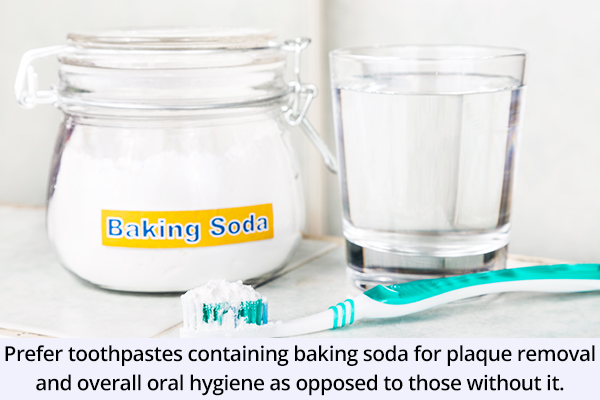
Baking soda is considered to be a gentle abrasive that may help scrape off the plaque biofilm from your teeth without eroding the enamel. It may also work as a mild exfoliant to remove stains from your teeth.
Several studies have favored the use of dentifrices or toothpaste containing baking soda for plaque removal and overall oral hygiene as opposed to those without it. (3)(4)(5)
How to use:
Gently brush your teeth with a small amount of baking soda once a week, but remember to rinse your mouth and teeth thoroughly thereafter.
Note: For all it’s worth, baking soda is still a relatively harsh ingredient that is not to be used in excess or for a prolonged period as it may end up eroding the tooth enamel over time.
Baking soda works as an alkalizing agent that can help neutralize your salivary pH and make your mouth uninhabitable for the plaque-producing bacteria.
3. Apply aloe vera
Aloe vera is known to impart freshness to the mouth by combating bad breath, which is also a by-product of bacterial accumulation in the mouth.
Studies found aloe vera to be as effective as the regularly used chlorhexidine mouthwash in combating plaque and gingivitis. (6)(7)
How to use:
Apply the pulpy flesh contained in an aloe vera leaf to your teeth and gums for approximately 10 minutes and then rinse it off with cold water. For maximum effect, use this topical remedy two times a day.
Aloe vera is known for its antimicrobial property, which may be utilized to address plaque and tartar buildup in the mouth due to bacterial overgrowth.
4. Use green tea as a mouthwash
Green tea is packed with a heavy dose of catechins and polyphenols that may aid your oral health in more ways than one.
A green tea mouthwash may reduce the risk of plaque formation and tooth decay by inhibiting the corrosive activity of oral bacteria.
In fact, some studies have compared the antiplaque activity of green tea to any regular variety of chlorhexidine-containing mouthwash. (8)(9) However, more large-scale research is needed to conclusively establish the beneficial effects of green tea in combating dental plaque.
How to use:
Prepare a cup of green tea and allow it to cool down to room temperature before using it as a mouth rinse for plaque removal.
Green tea is recognized as a wholesome therapeutic potion that is known to exhibit both antioxidant and antimicrobial properties. Moreover, green tea has a considerable fluoride content, which only adds to its tooth-protective prowess.
5. Use cranberry-containing dentifrices
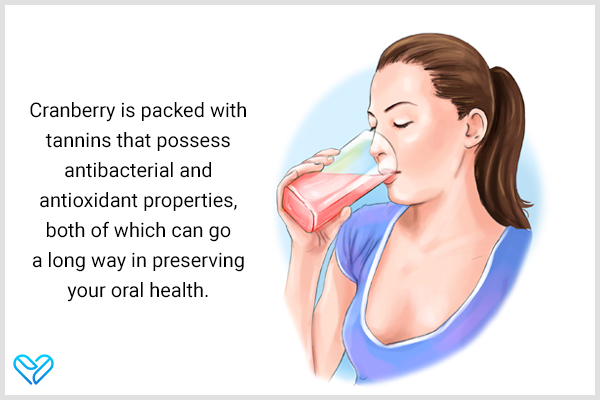
Cranberry is packed with tannins that possess antibacterial and antioxidant properties, both of which can go a long way in preserving your oral health. It can inhibit plaque and tartar accumulation as well as ward off several systemic infections that can be traced back to oral microorganisms.
Cranberry may even keep the plaque-producing bacteria from sticking to the dental surface, making the biofilm easier to remove.
Several studies have highlighted the efficacy of cranberry-containing dentifrices in reducing the growth of oral microbes, particularly the plaque-inducing Streptococcus mutans when used regularly. (10)(11)(12) However, more large-scale studies are needed to conclusively establish these claims.
How to use:
Use a cranberry-based mouthwash or consume cranberry juice to reduce your plaque scores and improve your overall oral health.
Caution: Cranberry juice is fairly acidic and contains undesirable sugar/carbohydrates that can be damaging if taken in large amounts.
Cranberry mouthwash can be just as effective as the traditional antibacterial agent used in mouthwashes called chlorhexidine and can yield both local and systemic benefits.
6. Eat more cheese
One way to neutralize the acidic environment of your mouth is by eating more dairy products such as cheese, which figures high on the pH scale. Cheese is also rich in tooth-building minerals such as calcium and phosphate, which can help fortify your teeth against plaque-induced damage.
Dairy products such as cheese and yogurt without any added sugars can help in maintaining a healthy oral pH, strengthening your teeth, and inhibiting the growth of plaque-forming bacteria. (13)(14)
7. Use orange juice and peel to remove tartar
The peel and juice of an orange can be used to remove the stubborn tartar deposits from your teeth.
The citric acid present in orange juice can break down the calcified tartar so that it becomes easier to remove. Once the tartar has softened, you can wipe it off with the fibrous skin of an orange.
One study demonstrated that the vitamin C in oranges helped strengthen teeth and assist the body in clearing away the bacteria in tartar. (15)
How to use:
- Apply a little orange juice all over your teeth and let it sit for about 5 minutes to loosen the plaque/tartar.
- Gently rub the orange peel on the teeth to remove the softened plaque/tartar.
- Rinse your mouth with a mouthwash.
8. Chew some guava leaves
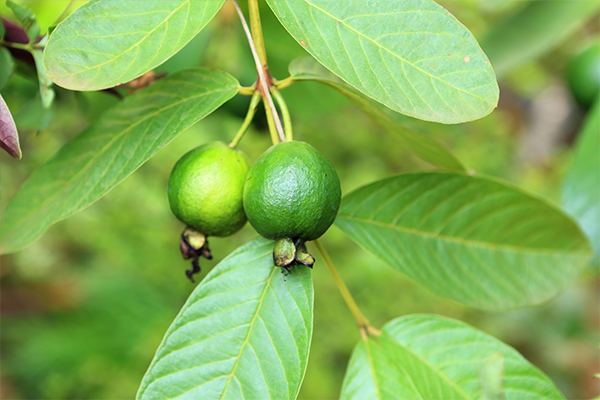
Guava is known for its anti-inflammatory properties that help in removing plaque accumulated on the teeth and gums and reduce the gingival swelling and pain associated with it. (16)
How to use:
Wash a few guava leaves and chew them thoroughly so that their juice covers your teeth, tongue, and gums before spitting them out. Do this every day to reduce plaque formation on the teeth.
9. Rinse your mouth with diluted white vinegar
White vinegar has antibacterial properties that can inhibit the buildup of oral bacteria, which ultimately results in the formation of plaque and tartar. (17) Moreover, the acetic acid present in vinegar can help demineralize the tooth enamel and break down the hardened tartar for easy removal.
How to use:
- Mix 2 teaspoons of white vinegar and ½ teaspoon of salt in ½ cup of water.
- Use this solution as a mouth rinse twice a day to reduce plaque buildup.
Caution: Don’t use undiluted white vinegar to clean your teeth as it’s too strong and can erode the enamel over time.
Self-Care Tips for Maintaining Oral Health
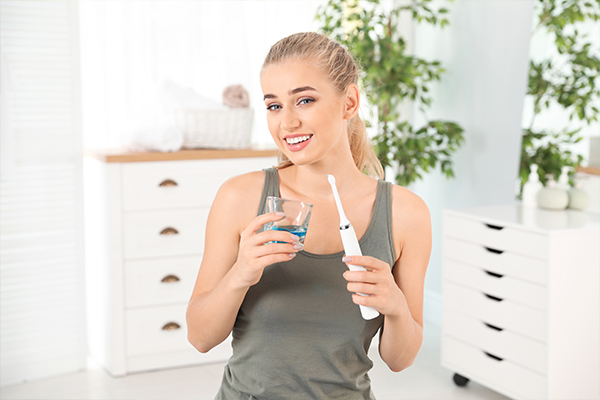
Here are some important dos and don’ts for proper oral hygiene:
1. Brush your teeth twice a day
Choose a toothbrush that has soft nylon bristles with rounded edges and replace it every 2–3 months.
When brushing your teeth, hold the toothbrush at a 45° angle against your gumline for maximum cleaning action and don’t forget to clean the inner surfaces of the teeth, which have major plaque deposits.
2. Use fluoride-containing toothpaste
Ideally, use fluoride-containing toothpaste. Fluoride is one of the best dental protective agents there is. Triclosan is another desirable component in oral products that helps combat the plaque-forming bacteria.
You can find many kinds of toothpaste on the market that are specifically designed for plaque or tartar control.
3. Scrape your tongue
Make sure to scrape your tongue when brushing to dislodge any food debris and curb the bacterial overgrowth that ultimately causes plaque buildup.
4. Floss your teeth regularly
Floss your teeth regularly as it helps to get the gunk out from the areas that are usually beyond the reach of the toothbrush.
5. Use a chlorhexidine-containing mouthwash
Use a chlorhexidine-containing mouthwash to give your oral cavity an added dose of cleansing.
You can also try a mouthwash with sage extract, which has been found especially effective against Streptococcus mutans, the prime culprit for the formation of dental plaque. (18)
6. Rinse your mouth after every meal
Rinse your mouth after every meal to help trigger the salivary glands into action. The swishing action of the water in the mouth compounded by the increased secretion of saliva helps remove any bacteria or food particles from the mouth.
7. Go for regular dental checkups
Get your teeth professionally examined and cleaned, preferably every 6 months.
8. Go for tooth polishing
Although it is best performed by a professional, at-home polishing kits are now commercially available. If you are thinking of trying tooth polishing by yourself, it is recommended to consult your dentist first.
9. Brush your teeth after consuming sugary, greasy, and sticky foods
Brush your teeth after eating sugar-laden, greasy, and sticky foods as they are some of the major contributors to oral plaque.
10. Avoid consuming any food or beverage post-bedtime brushing
Avoid consuming any food or beverage post-bedtime brushing as this defeats the whole purpose of the activity.
Note: Overcleaning your teeth with rigorous, forceful, or daily scraping is counterproductive and can further damage your already sensitive dental structure. For any kind of intensive cleaning, you must visit your dentist instead of doing it yourself at home.
Additional Dietary Tips

Consuming a wholesome, nutrient-dense diet is essential for keeping your teeth and gums in the best of health. Here are a few foods that are especially helpful for preserving your oral health:
- Hot and spicy foods can help stimulate your salivary glands to produce more saliva, which can help naturally clean your teeth and gums.
- Minimize your intake of processed foods, which are typically replete with starch and sugar that serve as food for oral bacteria and thereby promote plaque formation.
- Increase your intake of cruciferous vegetables, which require a lot of chewing and have a slightly rough texture that can help scrape the plaque from your teeth and gums.
- Chewing a crunchy fruit such as apple or figs can help increase salivary production in the mouth and can gently scrub your oral surfaces. Do this an hour after you have had your meal to get rid of any food remnants stuck on your teeth, gums, or tongue. A dry mouth provides the perfect breeding ground for plaque bacteria, so it is very important to keep yourself well hydrated by drinking a lot of fluids throughout the day.
Final Word
If you notice your teeth turning a yellowish hue, waste no time in getting them cleaned. Early treatment is key to keep the condition from worsening because once the plaque hardens to form tartar, it becomes even more difficult to remove.

- Was this article helpful?
- YES, THANKS!NOT REALLY



